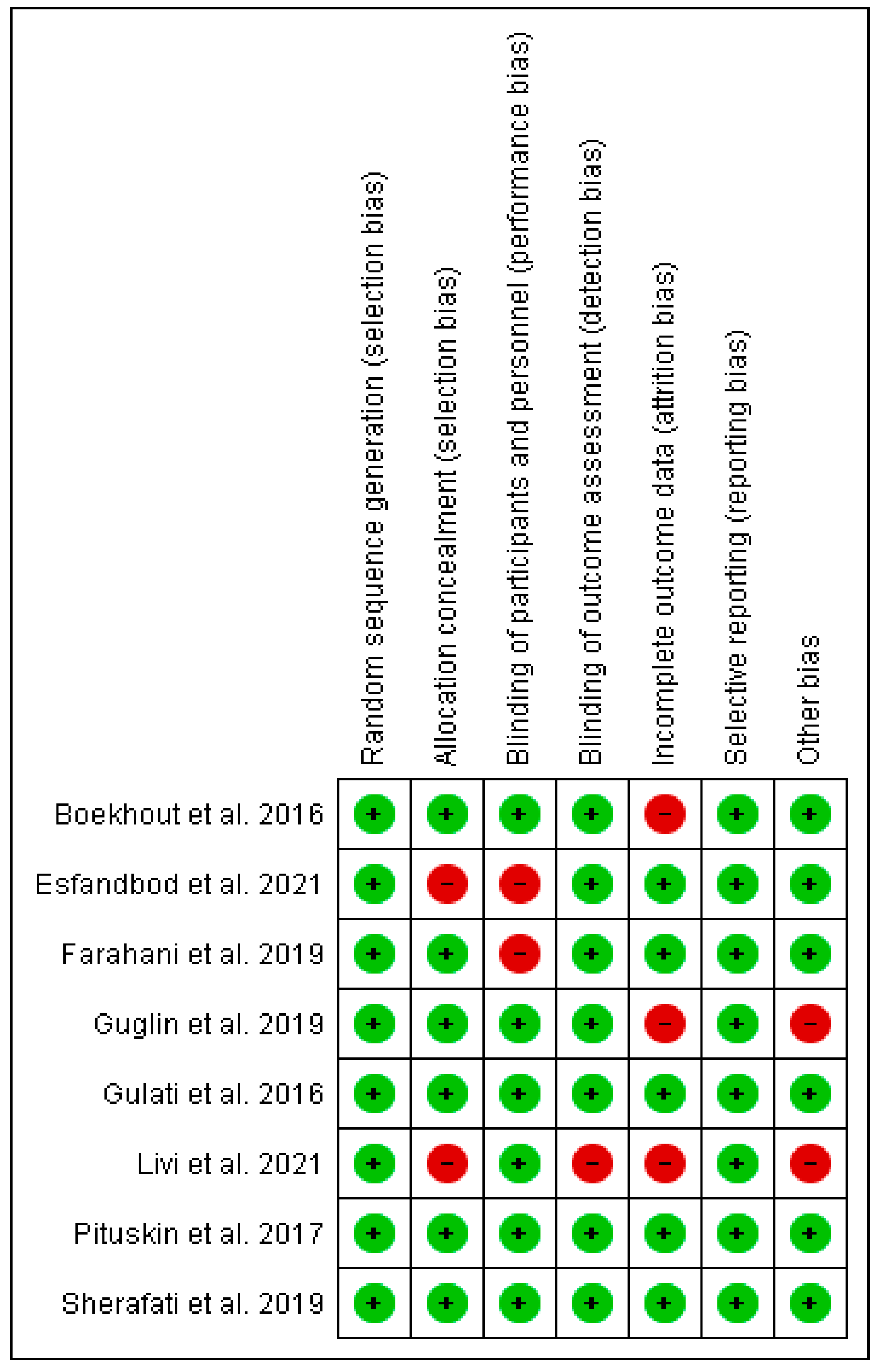Cardioprotective Agents for the Primary Prevention of Trastuzumab-Associated Cardiotoxicity: A Systematic Review and Meta-Analysis
Abstract
1. Introduction
2. Materials and Methods
2.1. Search Strategy, Eligibility Criteria and Outcomes
2.2. Data Collection and Extraction
2.3. Quality Assessment
2.4. Statistical Analysis
3. Results and Discussion
3.1. Search Results
3.2. Study and Patient Characteristics
3.3. Primary and Secondary Outcomes
4. Conclusions
Author Contributions
Funding
Institutional Review Board Statement
Informed Consent Statement
Data Availability Statement
Conflicts of Interest
References
- Giaquinto, A.N.; Sung, H.; Miller, K.D.; Kramer, J.L.; Newman, L.A.; Minihan, A.; Jemal, A.; Siegel, R.L. Breast Cancer Statistics, 2022. CA A Cancer J. Clin. 2022, 72, 524–541. [Google Scholar] [CrossRef] [PubMed]
- Wilkinson, L.; Gathani, T. Understanding Breast Cancer as a Global Health Concern. Br. J. Radiol. 2022, 95, 20211033. [Google Scholar] [CrossRef] [PubMed]
- Lin, M.; Xiong, W.; Wang, S.; Li, Y.; Hou, C.; Li, C.; Li, G. The Research Progress of Trastuzumab-Induced Cardiotoxicity in HER-2-Positive Breast Cancer Treatment. Front. Cardiovasc. Med. 2022, 8, 2075. [Google Scholar] [CrossRef] [PubMed]
- Curigliano, G.; Disalvatore, D.; Esposito, A.; Pruneri, G.; Lazzeroni, M.; Guerrieri-Gonzaga, A.; Luini, A.; Orecchia, R.; Goldhirsch, A.; Rotmensz, N.; et al. Risk of Subsequentin Situ and Invasive Breast Cancer in Human Epidermal Growth Factor Receptor 2-Positive Ductal Carcinomain Situ. Ann. Oncol. 2015, 26, 682–687. [Google Scholar] [CrossRef]
- Gonzalez-Angulo, A.M.; Litton, J.K.; Broglio, K.R.; Meric-Bernstam, F.; Rakkhit, R.; Cardoso, F.; Peintinger, F.; Hanrahan, E.O.; Sahin, A.; Guray, M.; et al. High Risk of Recurrence for Patients with Breast Cancer Who Have Human Epidermal Growth Factor Receptor 2–Positive, Node-Negative Tumors 1 Cm or Smaller. J. Clin. Oncol. 2009, 27, 5700–5706. [Google Scholar] [CrossRef]
- Allred, D.C.; Clark, G.M.; Tandon, A.K.; Molina, R.; Tormey, D.C.; Osborne, C.K.; Gilchrist, K.W.; Mansour, E.G.; Abeloff, M.; Eudey, L. HER-2/Neu in Node-Negative Breast Cancer: Prognostic Significance of Overexpression Influenced by the Presence of in Situ Carcinoma. J. Clin. Oncol. 1992, 10, 599–605. [Google Scholar] [CrossRef]
- Press, M.F.; Pike, M.C.; Chazin, V.R.; Hung, G.; Udove, J.A.; Markowicz, M.; Danyluk, J.; Godolphin, W.; Sliwkowski, M.; Akita, R. Her-2/Neu Expression in Node-Negative Breast Cancer: Direct Tissue Quantitation by Computerized Image Analysis and Association of Overexpression with Increased Risk of Recurrent Disease. Cancer Res. 1993, 53, 4960–4970. [Google Scholar]
- Trastuzumab: A Medicine to Treat Some Types of Cancer. nhs.uk. Available online: https://www.nhs.uk/medicines/trastuzumab-herceptin (accessed on 28 April 2023).
- Maximiano, S.; Magalhães, P.; Guerreiro, M.P.; Morgado, M. Trastuzumab in the Treatment of Breast Cancer. BioDrugs 2016, 30, 75–86. [Google Scholar] [CrossRef] [PubMed]
- Slamon, D.; Eiermann, W.; Robert, N.; Pienkowski, T.; Martin, M.; Press, M.; Mackey, J.; Glaspy, J.; Chan, A.; Pawlicki, M.; et al. Adjuvant Trastuzumab in HER2-Positive Breast Cancer. New Engl. J. Med. 2011, 365, 1273–1283. [Google Scholar] [CrossRef]
- Lv, S.; Wang, Y.; Sun, T.; Wan, D.; Sheng, L.; Li, W.; Zhu, H.; Li, Y.; Lu, J. Overall Survival Benefit from Trastuzumab-Based Treatment in HER2-Positive Metastatic Breast Cancer: A Retrospective Analysis. Oncol. Res. Treat. 2018, 41, 450–455. [Google Scholar] [CrossRef]
- Perez, E.A.; Romond, E.H.; Suman, V.J.; Jeong, J.-H.; Sledge, G.; Geyer, C.E.; Martino, S.; Rastogi, P.; Gralow, J.; Swain, S.M.; et al. Trastuzumab plus Adjuvant Chemotherapy for Human Epidermal Growth Factor Receptor 2–Positive Breast Cancer: Planned Joint Analysis of Overall Survival from NSABP B-31 and NCCTG N9831. J. Clin. Oncol. 2014, 32, 3744–3752. [Google Scholar] [CrossRef] [PubMed]
- Kumar, D.; Basu, S.; Goyal, R.K.; Sahoo, P.K.; Mathur, R. Comparison of Adverse Effects of Trastuzumab with Other Drug Combinations for the Treatment of Breast Cancer: A Review. Indian J. Physiol. Pharmacol. 2022, 66, 1–15. [Google Scholar] [CrossRef]
- Zamorano, J.L.; Lancellotti, P.; Muñoz, D.R.; Aboyans, V.; Asteggiano, R.; Galderisi, M.; Habib, G.; Lenihan, D.J.; Lip, G.Y.H.; Lyon, A.R.; et al. 2016 ESC Position Paper on Cancer Treatments and Cardiovascular Toxicity Developed under the Auspices of the ESC Committee for Practice Guidelines. Kardiologia Polska 2016, 74, 1193–1233. [Google Scholar] [CrossRef]
- Lyon, A.R.; López-Fernández, T.; Couch, L.S.; Asteggiano, R.; Aznar, M.C.; Bergler-Klein, J.; Boriani, G.; Cardinale, D.; Cordoba, R.; Cosyns, B.; et al. 2022 ESC Guidelines on Cardio-Oncology Developed in Collaboration with the European Hematology Association (EHA), the European Society for Therapeutic Radiology and Oncology (ESTRO) and the International Cardio-Oncology Society (IC-OS). Eur. Hear. J. -Cardiovasc. Imaging 2022, 23, e333–e465. [Google Scholar] [CrossRef]
- Mavroudis, D.; Saloustros, E.; Malamos, N.; Kakolyris, S.; Boukovinas, I.; Papakotoulas, P.; Kentepozidis, N.; Ziras, N.; Georgoulias, V. Six versus 12 Months of Adjuvant Trastuzumab in Combination with Dose-Dense Chemotherapy for Women with HER2-Positive Breast Cancer: A Multicenter Randomized Study by the Hellenic Oncology Research Group (HORG). Ann. Oncol. 2015, 26, 1333–1340. [Google Scholar] [CrossRef]
- Earl, H.M.; Hiller, L.; Vallier, A.-L.; Loi, S.; McAdam, K.; Hughes-Davies, L.; Harnett, A.N.; Ah-See, M.-L.; Simcock, R.; Rea, D.; et al. 6 versus 12 Months of Adjuvant Trastuzumab for HER2-Positive Early Breast Cancer (PERSEPHONE): 4-Year Disease-Free Survival Results of a Randomised Phase 3 Non-Inferiority Trial. Lancet 2019, 393, 2599–2612. [Google Scholar] [CrossRef] [PubMed]
- Cardoso, F.; Kyriakides, S.; Ohno, S.; Penault-Llorca, F.; Poortmans, P.; Rubio, I.T.; Zackrisson, S.; Senkus, E. Early Breast Cancer: ESMO Clinical Practice Guidelines for Diagnosis, Treatment and Follow-Up†. Ann. Oncol. 2019, 30, 1194–1220. [Google Scholar] [CrossRef]
- Lewinter, C.; Nielsen, T.H.; Edfors, L.R.; Linde, C.; Bland, J.M.; LeWinter, M.; Cleland, J.G.F.; Køber, L.; Braunschweig, F.; Mansson-Broberg, A. A Systematic Review and Meta-Analysis of Beta-Blockers and Renin–Angiotensin System Inhibitors for Preventing Left Ventricular Dysfunction due to Anthracyclines or Trastuzumab in Patients with Breast Cancer. Eur. Heart J. 2021, 43, 2562–2569. [Google Scholar] [CrossRef]
- Shah, P.; Garris, R.; Abboud, R.; Vasudev, R.; Patel, H.; Doshi, R.; Shamoon, F.; Bikkina, M. Meta-Analysis Comparing Usefulness of Beta Blockers to Preserve Left Ventricular Function during Anthracycline Therapy. Am. J. Cardiol. 2019, 124, 789–794. [Google Scholar] [CrossRef]
- Kalam, K.; Marwick, T.H. Role of Cardioprotective Therapy for Prevention of Cardiotoxicity with Chemotherapy: A Systematic Review and Meta-Analysis. Eur. J. Cancer 2013, 49, 2900–2909. [Google Scholar] [CrossRef]
- Omland, T.; Heck, S.L.; Gulati, G. The Role of Cardioprotection in Cancer Therapy Cardiotoxicity. JACC: CardioOncology 2022, 4, 19–37. [Google Scholar] [CrossRef] [PubMed]
- Tajiri, K.; Aonuma, K.; Sekine, I. Cardio-Oncology: A Multidisciplinary Approach for Detection, Prevention and Management of Cardiac Dysfunction in Cancer Patients. Jpn. J. Clin. Oncol. 2017, 47, 678–682. [Google Scholar] [CrossRef] [PubMed]
- Brown, S.-A.; Okwuosa, T.M.; Barac, A.; Volgman, A.S. The Role of Angiotensin-Converting Enzyme Inhibitors and β-Blockers in Primary Prevention of Cardiac Dysfunction in Breast Cancer Patients. J. Am. Heart Assoc. 2020, 9, e015327. [Google Scholar] [CrossRef]
- Brown, L.J.; Meredith, T.; Yu, J.; Patel, A.; Neal, B.; Arnott, C.; Lim, E. Heart Failure Therapies for the Prevention of HER2-Monoclonal Antibody-Mediated Cardiotoxicity: A Systematic Review and Meta-Analysis of Randomized Trials. Cancers 2021, 13, 5527. [Google Scholar] [CrossRef]
- Obasi, M.; Abovich, A.; Vo, J.B.; Gao, Y.; Papatheodorou, S.; Nohria, A.; Asnani, A.; Partridge, A.H. Statins to Mitigate Cardiotoxicity in Cancer Patients Treated with Anthracyclines And/or Trastuzumab: A Systematic Review and Meta-Analysis. Cancer Causes Control 2021, 32, 1395–1405. [Google Scholar] [CrossRef]
- Elghazawy, H.; Venkatesulu, B.P.; Verma, V.; Pushparaji, B.; Monlezun, D.J.; Marmagkiolis, K.; Iliescu, C.A. The Role of Cardio-Protective Agents in Cardio-Preservation in Breast Cancer Patients Receiving Anthracyclines ± Trastuzumab: A Meta-Analysis of Clinical Studies. Crit. Rev. Oncol. /Hematol. 2020, 153, 103006. [Google Scholar] [CrossRef]
- Page, M.J.; McKenzie, J.E.; Bossuyt, P.M.; Boutron, I.; Hoffmann, T.C.; Mulrow, C.D.; Shamseer, L.; Tetzlaff, J.M.; Akl, E.A.; Brennan, S.E.; et al. The PRISMA 2020 Statement: An Updated Guideline for Reporting Systematic Reviews. Br. Med. J. 2021, 372, n71. [Google Scholar] [CrossRef]
- Heidenreich, P.A.; Bozkurt, B.; Aguilar, D.; Allen, L.A.; Byun, J.J.; Colvin, M.M.; Deswal, A.; Drazner, M.H.; Dunlay, S.M.; Evers, L.R.; et al. 2022 AHA/ACC/HFSA Guideline for the Management of Heart Failure: A Report of the American College of Cardiology/American Heart Association Joint Committee on Clinical Practice Guidelines. J. Am. Coll. Cardiol. 2022, 79, e263–e421. [Google Scholar] [CrossRef] [PubMed]
- Sterne, J.A.C.; Savović, J.; Page, M.J.; Elbers, R.G.; Blencowe, N.S.; Boutron, I.; Cates, C.J.; Cheng, H.-Y.; Corbett, M.S.; Eldridge, S.M.; et al. RoB 2: A Revised Tool for Assessing Risk of Bias in Randomised Trials. BMJ 2019, 366, l4898. [Google Scholar] [CrossRef] [PubMed]
- Higgins, J.; Green, S.; Ben Van Den, A. Cochrane Handbook for Systematic Reviews of Interventions; Wiley: Hoboken, NJ, USA, 2008. [Google Scholar]
- Livi, L.; Barletta, G.; Martella, F.; Saieva, C.; Desideri, I.; Bacci, C.; Del Bene, M.R.; Airoldi, M.; Amoroso, D.; Coltelli, L.; et al. Cardioprotective Strategy for Patients with Nonmetastatic Breast Cancer Who Are Receiving an Anthracycline-Based Chemotherapy: A Randomized Clinical Trial. JAMA Oncol. 2021, 7, 1544–1549. [Google Scholar] [CrossRef] [PubMed]
- Gulati, G.; Heck, S.L.; Ree, A.H.; Hoffmann, P.; Schulz-Menger, J.; Fagerland, M.W.; Gravdehaug, B.; von Knobelsdorff-Brenkenhoff, F.; Bratland, Å.; Storås, T.H.; et al. Prevention of Cardiac Dysfunction during Adjuvant Breast Cancer Therapy (PRADA): A 2 × 2 Factorial, Randomized, Placebo-Controlled, Double-Blind Clinical Trial of Candesartan and Metoprolol. Eur. Heart J. 2016, 37, 1671–1680. [Google Scholar] [CrossRef] [PubMed]
- Esfandbod, M.; Naderi, M.; Sadatnaseri, A.; Ahmadi, A.; Noroozi, M.; Sadeghi Joni, S. Evaluation of the Preventive Effects of Carvedilol on Trastuzumab-Induced Cardiotoxicity in Early-Stage and Locally Advanced HER2-Positive Breast Cancer Patients. Int. J. Hematol. -Oncol. Stem Cell Res. 2021, 15, 206. [Google Scholar] [CrossRef] [PubMed]
- Guglin, M.; Krischer, J.; Tamura, R.; Fink, A.; Bello-Matricaria, L.; McCaskill-Stevens, W.; Munster, P.N. Randomized Trial of Lisinopril versus Carvedilol to Prevent Trastuzumab Cardiotoxicity in Patients with Breast Cancer. J. Am. Coll. Cardiol. 2019, 73, 2859–2868. [Google Scholar] [CrossRef] [PubMed]
- Pituskin, E.; Mackey, J.R.; Koshman, S.; Jassal, D.; Pitz, M.; Haykowsky, M.J.; Pagano, J.J.; Chow, K.; Thompson, R.B.; Vos, L.J.; et al. Multidisciplinary Approach to Novel Therapies in Cardio-Oncology Research (MANTICORE 101–Breast): A Randomized Trial for the Prevention of Trastuzumab-Associated Cardiotoxicity. J. Clin. Oncol. 2017, 35, 870–877. [Google Scholar] [CrossRef] [PubMed]
- Boekhout, A.H.; Gietema, J.A.; Milojkovic Kerklaan, B.; van Werkhoven, E.D.; Altena, R.; Honkoop, A.; Los, M.; Smit, W.M.; Nieboer, P.; Smorenburg, C.H.; et al. Angiotensin II–Receptor Inhibition with Candesartan to Prevent Trastuzumab-Related Cardiotoxic Effects in Patients with Early Breast Cancer. JAMA Oncol. 2016, 2, 1030–1037. [Google Scholar] [CrossRef] [PubMed]
- Farahani, M.; Nourian, S.; Jalalian, H.R.; Khosravi, A.; Salesi, Μ. Efficacy of Treatment With Carvedilol in Preventing Early-Stage Left Ventricular Dysfunction in Patients With Breast Cancer Candidated to Receive Trastuzumab Using 2D Speckle-Tracking Echocardiography. Iran. Heart J. 2019, 20, 20–31. [Google Scholar]
- Sherafati, A.; Mehrpooya, M.; Sattarzadeh Badkoubeh, R.; Larti, F.; Shahi, F.; Mirzania, M.; Esfandbod, M.; Saadat, M.; Ghasemi, M.; Zebardast, J. Assessment of Carvedilol Therapy in Prevention of Heart Failure in HER2 Positive Breast Cancer Patients Receiving Trastuzumab. Acta Med. Iran. 2019, 57, 173–179. [Google Scholar] [CrossRef]
- Heck, S.L.; Mecinaj, A.; Ree, A.H.; Hoffmann, P.; Schulz-Menger, J.; Fagerland, M.W.; Gravdehaug, B.; Røsjø, H.; Steine, K.; Geisler, J.; et al. Prevention of Cardiac Dysfunction during Adjuvant Breast Cancer Therapy (PRADA): Extended Follow-up of a 2×2 Factorial, Randomized, Placebo-Controlled, Double-Blind Clinical Trial of Candesartan and Metoprolol. Circulation 2021, 143, 2431–2440. [Google Scholar] [CrossRef]
- Slamon, D.J.; Leyland-Jones, B.; Shak, S.; Fuchs, H.; Paton, V.; Bajamonde, A.; Fleming, T.; Eiermann, W.; Wolter, J.; Pegram, M.; et al. Use of Chemotherapy plus a Monoclonal Antibody against HER2 for Metastatic Breast Cancer That Overexpresses HER2. N. Engl. J. Med. 2001, 344, 783–792. [Google Scholar] [CrossRef]
- Armenian, S.H.; Lacchetti, C.; Barac, A.; Carver, J.; Constine, L.S.; Denduluri, N.; Dent, S.; Douglas, P.S.; Durand, J.-B.; Ewer, M.; et al. Prevention and Monitoring of Cardiac Dysfunction in Survivors of Adult Cancers: American Society of Clinical Oncology Clinical Practice Guideline. J. Clin. Oncol. Off. J. Am. Soc. Clin. Oncol. 2017, 35, 893–911. [Google Scholar] [CrossRef]
- Cardinale, D.; Colombo, A.; Torrisi, R.; Sandri, M.T.; Civelli, M.; Salvatici, M.; Lamantia, G.; Colombo, N.; Cortinovis, S.; Dessanai, M.A.; et al. Trastuzumab-Induced Cardiotoxicity: Clinical and Prognostic Implications of Troponin I Evaluation. J. Clin. Oncol. 2010, 28, 3910–3916. [Google Scholar] [CrossRef] [PubMed]
- Grela-Wojewoda, A.; Püsküllüoğlu, M.; Sas-Korczyńska, B.; Zemełka, T.; Pacholczak-Madej, R.; Wysocki, W.M.; Wojewoda, T.; Adamczyk, A.; Lompart, J.; Korman, M.; et al. Biomarkers of Trastuzumab-Induced Cardiac Toxicity in HER2- Positive Breast Cancer Patient Population. Cancers 2022, 14, 3353. [Google Scholar] [CrossRef] [PubMed]
- Ewer, M.S.; Ewer, S.M. Troponin I Provides Insight into Cardiotoxicity and the Anthracycline-Trastuzumab Interaction. J. Clin. Oncol. 2010, 28, 3901–3904. [Google Scholar] [CrossRef] [PubMed]
- Ponde, N.; Bradbury, I.; Lambertini, M.; Ewer, M.; Campbell, C.; Ameels, H.; Zardavas, D.; Di Cosimo, S.; Baselga, J.; Huober, J.; et al. Cardiac Biomarkers for Early Detection and Prediction of Trastuzumab And/or Lapatinib-Induced Cardiotoxicity in Patients with HER2-Positive Early-Stage Breast Cancer: A NeoALTTO Sub-Study (BIG 1-06). Breast Cancer Res. Treat. 2018, 168, 631–638. [Google Scholar] [CrossRef] [PubMed]
- Zardavas, D.; Suter, T.M.; Van Veldhuisen, D.J.; Steinseifer, J.; Noe, J.; Lauer, S.; Al-Sakaff, N.; Piccart-Gebhart, M.J.; de Azambuja, E. Evandro de Azambuja. Role of Troponins I and T and N-Terminal Prohormone of Brain Natriuretic Peptide in Monitoring Cardiac Safety of Patients with Early-Stage Human Epidermal Growth Factor Receptor 2–Positive Breast Cancer Receiving Trastuzumab: A Herceptin Adjuvant Study Cardiac Marker Substudy. J. Clin. Oncol. 2017, 35, 878–884. [Google Scholar] [CrossRef] [PubMed]
- Khan, G.; Alam, M.F.; Alshahrani, S.; Almoshari, Y.; Jali, A.M.; Alqahtani, S.; Khalid, M.; Nasar, S.; Anwer, T. Trastuzumab-Mediated Cardiotoxicity and Its Preventive Intervention by Zingerone through Antioxidant and Inflammatory Pathway in Rats. J. Pers. Med. 2023, 13, 750. [Google Scholar] [CrossRef]
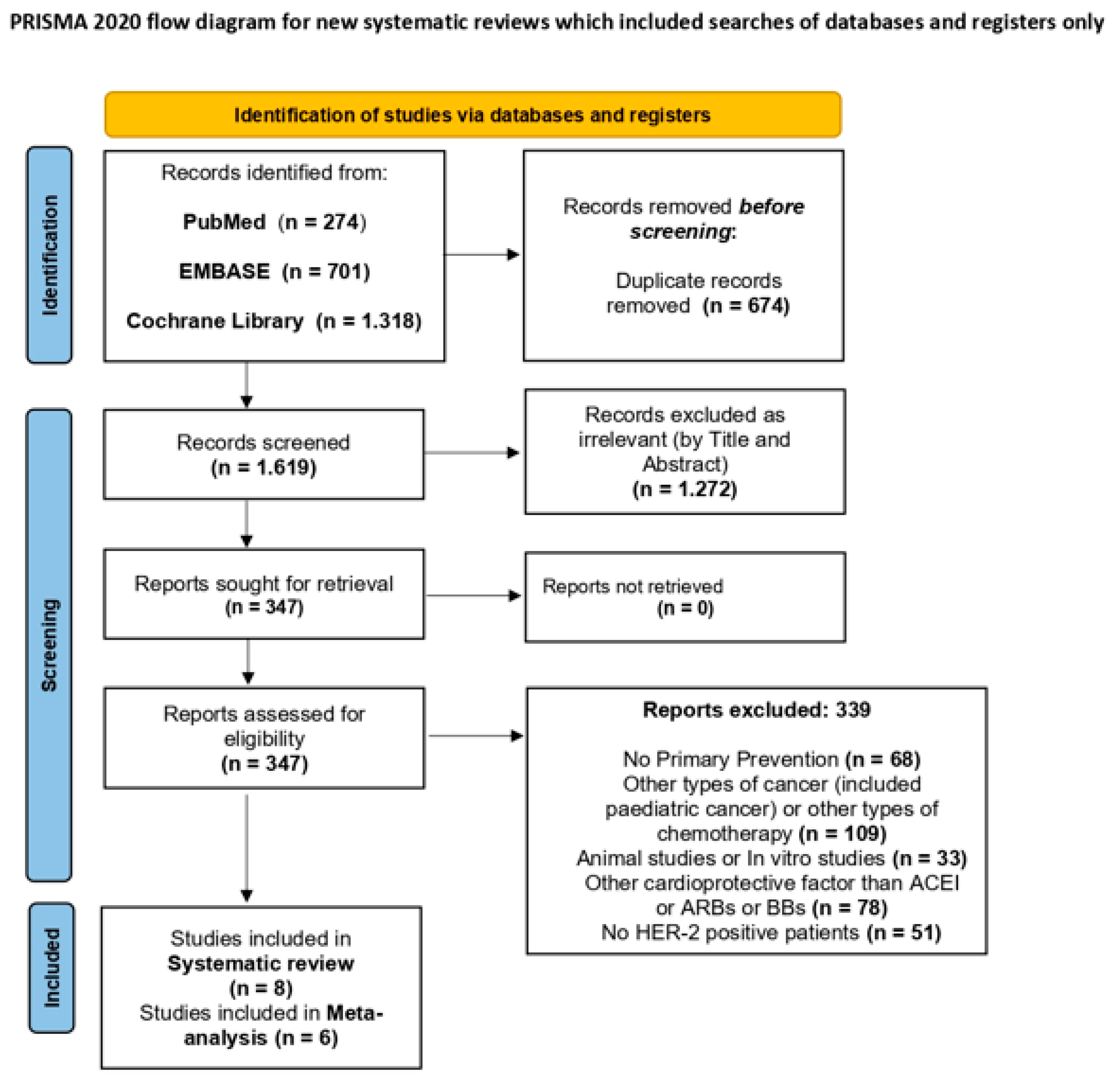
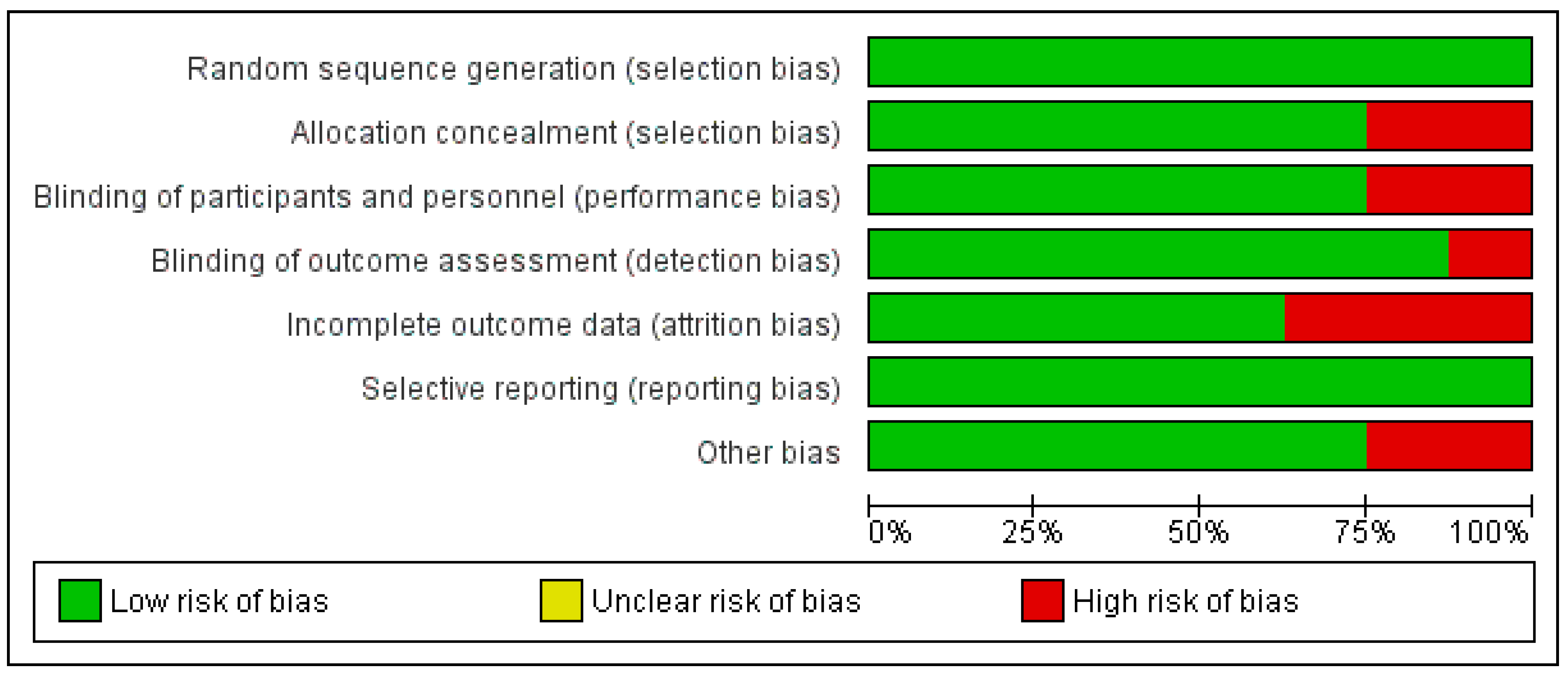
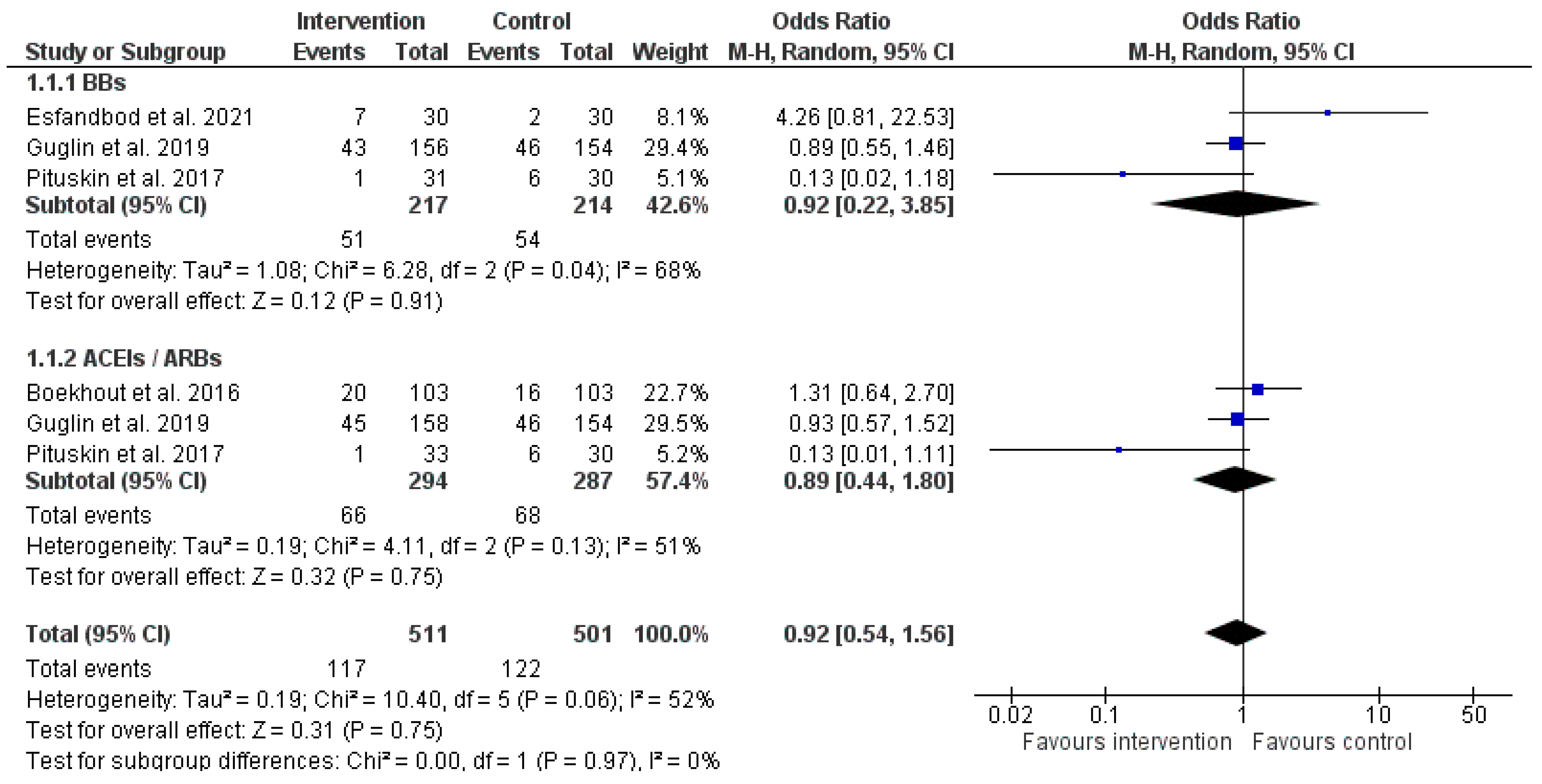
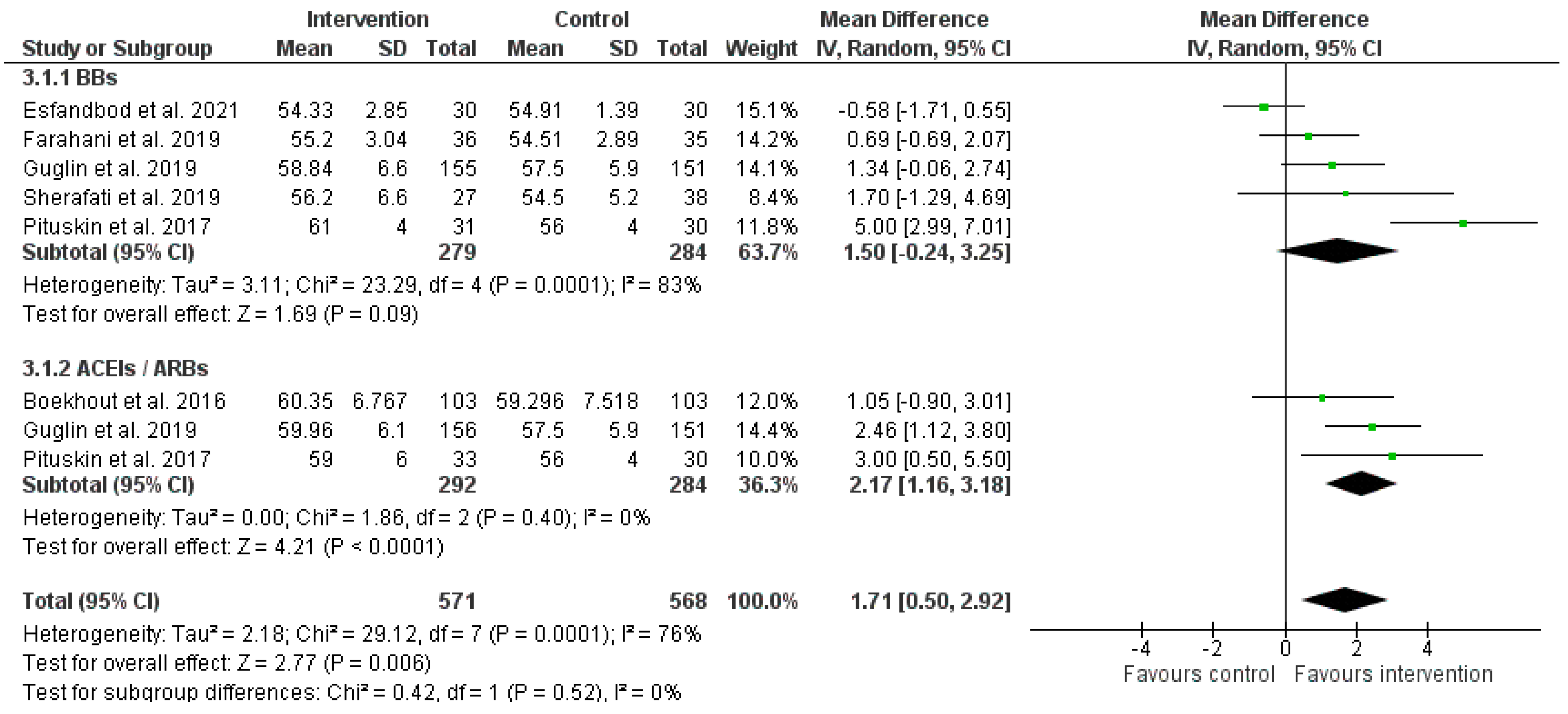
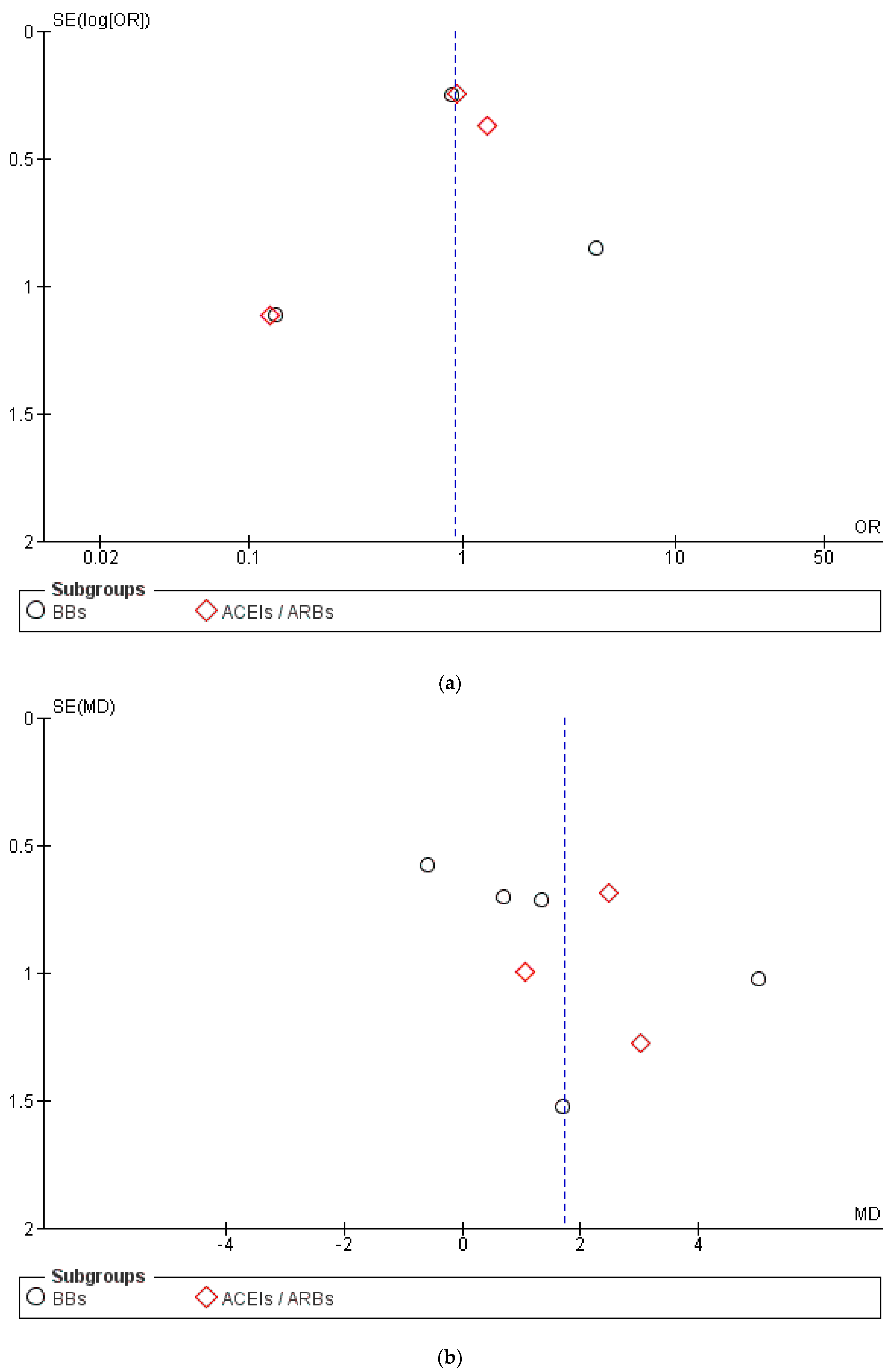
| Study ID | Type of Study | Sample Size | Age, Years | Hormonal Receptors Positive | Trastuzumab without Previous Use of Anthracyclines | Adjuvant Trastuzumab | Cardio Protective Agent | Dose of Medication | Type of Baseline Measurements | Duration of Follow-Up | Serum Biomarkers |
|---|---|---|---|---|---|---|---|---|---|---|---|
| Livi et al., 2021 [32] | Double-blind, placebo-controlled RCT | 174 | Median age 48 years | 132 | _ | 64 | Bisoprolol, Ramipril, or both | 5 mg Bisoprolol and/or 5 mg of Ramipril | Standard and 3D echocardiography | 24 months | No |
| Gulati et al., 2016 [33] | Double-blind, placebo-controlled RCT | 120 | Mean age 50.7 years | _ | _ | 28 | Candesartan cilexetil and Metoprolol succinate | Starting dose for candesartan cilexetil was 8 mg and for metoprolol succinate 50 mg, target dose 32 and 100 mg, respectively | CMR and Echocardiography | No follow-up information beyond the adjuvant therapy period | Cardiac troponin I and B-type natriuretic peptide (BNP) |
| Esfandbod et al., 2021 [34] | Simple RCT | 60 | Mean age 47 years | 60 non-metastatic Her-2 positive patients | _ | 60 | Carvedilol | The dose has been increased in a three-week period to reach 12.5 mg twice a day and continued until the end of therapy. | Echocardiography | 12 months | No |
| Guglin et al., 2019 [35] | Double-blind, placebo-controlled RCT | 468 | Mean age 51 years | 468 HER-2 positive | 279 | 468 | Lisinopril, Carvedilol | 10 mg once daily | MUGA | 12 months | Troponin I and B-type natriuretic peptide (BNP) |
| Pituskin et al., 2017 [36] | Double-blind, placebo-controlled RCT | 94 | Mean age 51.3 years | 94 HER-2 positive | _ | 94 | Perindopril, Bisoprolol | Daily target doses of Perindopril 8 mg, Bisoprolol 10 mg after was initiated with Perindopril 2 mg daily and Bisoprolol 2.5 mg daily. | CMR | 24 months | No |
| Boekhout et al., 2016 [37] | Double-blind, placebo-controlled RCT | 206 | Mean age 49.5 years | 206 HER-2 positive | _ | 206 | Candesartan | 32 mg daily | Echocardiography or MUGA | The median follow-up was 21 months | NT-proBNP and hs-TnT |
| Farahani et al., 2019 [38] | Open-label RCT | 71 | Mean age 57 years | 71 HER-2 positive | _ | 71 | Carvedilol | 6.25 mg twice a day, and 6.25 mg was added to each serving every week to the maximum tolerated dose (12.5 ± 3.125 mg twice a day) | 2DSTE | 3 months | No |
| Sherafati et al., 2019 [39] | Double-blind, usual care-controlled RCT | 65 | Mean age 46.5 years | 65 HER-2 positive | _ | 65 | Carvedilol | 6.25 mg twice daily | Echocardiography | 3 months | No |
| 8 | 1258 | 279 | 1056 |
Disclaimer/Publisher’s Note: The statements, opinions and data contained in all publications are solely those of the individual author(s) and contributor(s) and not of MDPI and/or the editor(s). MDPI and/or the editor(s) disclaim responsibility for any injury to people or property resulting from any ideas, methods, instructions or products referred to in the content. |
© 2023 by the authors. Licensee MDPI, Basel, Switzerland. This article is an open access article distributed under the terms and conditions of the Creative Commons Attribution (CC BY) license (https://creativecommons.org/licenses/by/4.0/).
Share and Cite
Goulas, K.; Farmakis, D.; Constantinidou, A.; Kadoglou, N.P.E. Cardioprotective Agents for the Primary Prevention of Trastuzumab-Associated Cardiotoxicity: A Systematic Review and Meta-Analysis. Pharmaceuticals 2023, 16, 983. https://doi.org/10.3390/ph16070983
Goulas K, Farmakis D, Constantinidou A, Kadoglou NPE. Cardioprotective Agents for the Primary Prevention of Trastuzumab-Associated Cardiotoxicity: A Systematic Review and Meta-Analysis. Pharmaceuticals. 2023; 16(7):983. https://doi.org/10.3390/ph16070983
Chicago/Turabian StyleGoulas, Kyriakos, Dimitrios Farmakis, Anastasia Constantinidou, and Nikolaos P. E. Kadoglou. 2023. "Cardioprotective Agents for the Primary Prevention of Trastuzumab-Associated Cardiotoxicity: A Systematic Review and Meta-Analysis" Pharmaceuticals 16, no. 7: 983. https://doi.org/10.3390/ph16070983
APA StyleGoulas, K., Farmakis, D., Constantinidou, A., & Kadoglou, N. P. E. (2023). Cardioprotective Agents for the Primary Prevention of Trastuzumab-Associated Cardiotoxicity: A Systematic Review and Meta-Analysis. Pharmaceuticals, 16(7), 983. https://doi.org/10.3390/ph16070983







